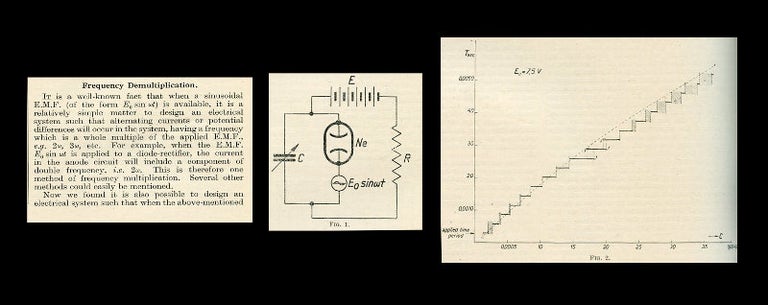Frequency demultiplication in Nature 120, Number 3019, 1927, pp. 363-364
Lancaster: American Physical Society, 1927. 1st Edition. FIRST EDITION IN ORIGINAL WRAPPERS OF "ONE OF THE FIRST EXPERIMENTAL REPORTS OF CHAOS" (Tsatsos, Theoretical and Numerical Study of the Van der Pol Equation, 9). Van der Pol and van der Mark note the appearance “of ‘irregular noise’ before transition from one sub-harmonical regime to another… [this being] one of the first observations of chaotic oscillations” (ibid). Other scientific historians have gone further, citing this as “the experimental discovery of chaotic dynamics” (Rosser, Chaos Theory Before Lorenz, 9).
The Dutch electrical engineer Balthasar van der Pol began with a vacuum tube. “A modern physics student would explore the behavior of such an oscillator by looking at the line traced on the screen of an oscilloscope. Van der Pol did not have an oscilloscope, so he had to monitor his circuit by listening to changing tones in a telephone handset. He was pleased to discover regularities in the behavior as he changed the current that fed it. The tone would leap from frequency to frequency as if climbing a staircase, leaving one frequency and then locking solidly onto the next. Yet once in a while van der Pol noted something strange. The behavior sounded irregular, in a way that he could not explain.
Under the circumstances he was not worried. ‘Often an irregular noise is heard in the telephone receivers before the frequency jumps to the next lower value,’ he wrote in a letter to Nature. “However, this is a subsidiary phenomenon.” He was one of many scientists who got a glimpse of chaos but had no language to understand it. For people trying to build vacuum tubes, the frequency-locking was important. But for people trying to understand the nature of complexity, the truly interesting behavior would turn out to be the ‘irregular noise’ created by the conflicting pulls of a higher and lower frequency” (Gleik, Chaos, 49). Item #459
CONDITION & DETAILS: Lancaster: American Physical Society. 4to. (10.5 x 8 inches; 263 x 200mm). Ex-libris with a handsome pictorial bookplate on the pastedown, blacked out spine label, fewer than usual markings. llustration: In-text illustrations throughout. Binding: Bound in green cloth with gilt-lettered spines. Minor rubbing and scuffing to the edge and spine tips. Solidly and very tightly bound. Interior: Bright and very clean throughout.
Price: $150.00

